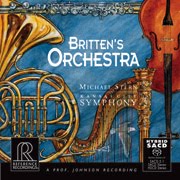A fantastic interview came out Tuesday in the KC Metropolis Journal, featuring our Britten’s Orchestra recording with the Kansas City Symphony. Today we want to share a little of that with you, and then encourage you to visit kcmetropolis.org to read the rest. It is well worth your time!
From KCMetropolis.org:
INTERVIEW: Achieving that Grammy Sound
By David Peironnet
David Peironnet:
“Dynamic range in its extreme” is a quote from your press release accompanying the Kansas City Symphony recording of Britten’s Orchestra. This must be exceptionally challenging for a producer and engineer, isn’t it?David Frost: For me the issue is whether the dynamic range is faithful to the score and realistic, yet at the same time is listenable to most people on a good system. The music on this album goes from a whisper to the thunderously loud. To me dynamic range for its own sake isn’t the point. In translating music into audio, one must consider the imperfections of the medium and compensate for them. Music with this kind of dynamic range does present a challenge, but I think this recording is successful in conveying its dramatic dynamic contrasts without surpassing the inherent limitations of the medium.
Keith Johnson: High resolution equipment I have built and use has plenty of headroom for a master recording that captures the full emotional-dramatic buildup dynamic of Stern’s performance and Britten’s intent. Difficulties would occur in trying to compress the program for the car commute, background listening and radio play. Better processing encourages a chronic mezzo-forte background that may lubricate social settings or play from weak equipment, but otherwise it is sonic death to great work. I did experiment a few times to reign in the performance but virtually everyone preferred the all out uncompromised rendering that captures the sense of concert and performance so well during serious undistracted listening.
DP: Britten’s Orchestra was recorded at the Community of Christ auditorium in Independence. Did that large, open area present any special challenges to you as you made your recording?
DF: Keith should answer this one. He did an amazing job of creating a clear and attractive sound that used this space to its best advantage.
KJ: This place is special and we are very fortunate to use it. The orchestra is more in the middle than most spaces so the audience around it hears powerful focused sound with secondary images from curved surfaces. Our “surround-sound” recording captures this wrap-around effect. In the recording, we hear clarity, fine detail and a very big stage. The Royal Albert Hall, Mormon Tabernacle and the now demolished Chicago Medinah temple [where the Chicago Symphony Orchestra recorded many works] would be world-class arena spaces with similar acoustic properties of immediacy, ability to delineate complexity and power—things I’m sure Britten would have preferred for these works…
Read the full interview at http://kcmetropolis.org
Purchase Britten’s Orchestra at http://referencerecordings.com

